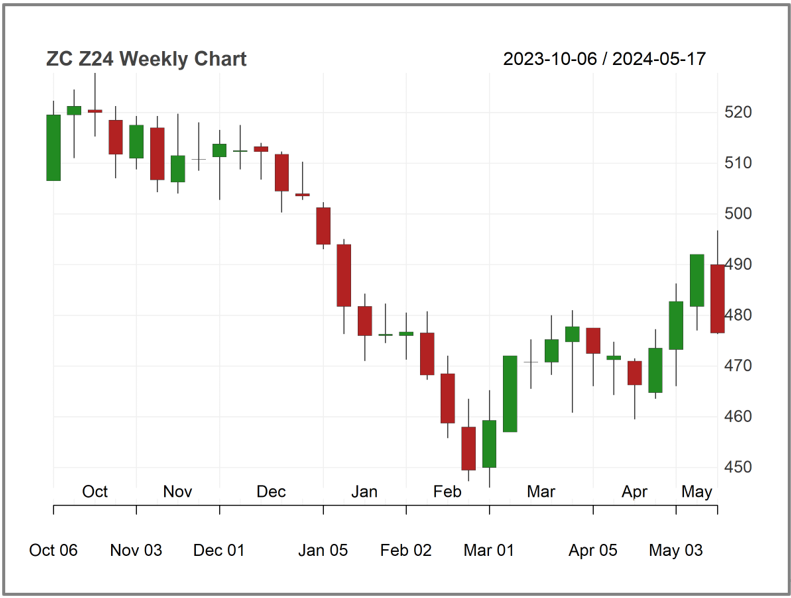
Source: CMEGroup
Price change this week
Last week, wheat and Corn Price falls, soybean Prices remained basically stable. however, Soybean oil The oil stock price recovered after finding support again.
With the planting work going on in an orderly manner, the market is turning its attention to the weather forecast, which will have a significant impact on crop yield in the coming months. The severity of adverse weather and the balance between supply and demand will lead to price fluctuations.
The latest CoT report shows that the fund has reduced its holdings Soybean meal The trend of short position and increase of long position.
Weather remains a key factor in exacerbating price volatility. Wheat in Kansas and the Black Sea region is more vulnerable to weather conditions, while soybean and corn prices will depend on weather conditions during planting.
The market is paying close attention to the planting progress, the weather conditions during planting and the realization of the expected planting area.
Although the market is generally stable, weather related disturbances have exacerbated price fluctuations. Wheat conditions in Kansas and the Black Sea have been significantly affected, while heavy rains have affected soybeans in Rio Grande. Later, the focus will turn to the weather conditions in July and August, which are the key months to determine crop yield.
In conclusion, the weather will continue to have a significant impact on price trends and market expectations.
grain
Last week, wheat prices rebounded first, but eventually ended flat. The reason for the fluctuation of wheat price may be the continuous frost and freezing risk in Russia, as well as the drought conditions in some parts of Kansas.
The field inspection report in Kansas shows that the final yield may be higher than the data released by the USDA in May, but if the hard red winter wheat is affected by high temperature and drought at the end of the growing season, there is still a risk.
Global wheat futures prices rose sharply due to the increase of supply risk premium. At present, there is no indication that key planting areas in Ukraine and Russia will need rainfall before June 1, and the model guidance shows that abnormal high temperature will appear in southern Russia at the end of May.
The USDA's global and export country supply and demand balance table shows that even if the weather conditions are normal, the supply situation will still tighten in 2024. In addition, the output of the EU and the Black Sea region may decrease by another 7 to 10 million tons, leading to a new low in the inventory utilization ratio of exporting countries.
Weekly trend of CBOT wheat futures (ZW)
If the weather forecast in Russia does not improve, prices in Kansas may rise further.
In the coming weeks, the seasonal peak of domestic crop production in the United States will be identified, because the production will usually be established during this period.
Some analysts predict that India may import 3~5 million tons of wheat in 2025/2026, but India's output is expected to meet domestic consumption, so this possibility is low before the next crop harvest.
In the next few weeks, the wheat price will reach a seasonal high and decline with the increase of the pressure on winter wheat harvest. To sum up, from now on, the growing season in the northern hemisphere will be the top priority, and near ideal conditions are needed to keep wheat prices stable.
Weekly trend of CBOT corn futures (ZC)
Due to the improvement of weather forecast during planting, CBOT corn futures experienced a correction last week. Warm and dry weather has occurred in most parts of the United States, and it is expected that 12% - 15% of the planting progress will be completed this week.
The weather has an increasing impact on daily price discovery, and traders should be prepared for the sharp fluctuations in the market from late May to August.
The weather conditions in July are crucial to the corn market, so the weather forecast for this month will be a key factor. Although the United States is not yet considered a late sowing year, weather forecasts for the coming weeks will be closely watched. Even a short period of dry weather can make significant progress in planting progress.
The stock of old crops in the United States is up to 2 billion bushels, which limits the upward space of prices. If the weather conditions in July and August are favorable, the corn yield in the United States may reach 178~182 bushels. The market is still seriously affected by weather conditions, and some bullish factors are being established.
Last week, the controlled monetary fund again reduced its short position and currently holds 71000 short contracts. The planting progress in the eastern part of the central and western regions is being closely watched, and an open window period is needed to complete the planting work on time. In the long run, the fair value will depend on the summer weather conditions in the United States and the current planting conditions.
Oilseed complex
Soybean futures traded in a relatively narrow range last week. July soybean futures were flat in fluctuations, but closed higher on Friday.
Market news is limited, and the planting progress is only 35%. It is predicted that there will still be rain in South Rio Grande, and the crop loss is estimated to be between 1 million and 4 million metric tons, but the specific data cannot be determined in the short term.
The soybean meal market was supported by the delayed harvest in Argentina and the slowdown of new crop crushing rate. US soybean meal exports remain at a record level, and Argentina's delayed harvest may force global end users to import more US soybean meal. The progress of soybean planting is slightly behind the average progress.
Weekly trend of CBOT soybean futures (ZS)
Brazil's soybean base continued to rise, despite the recent slowdown in the pace of exports. It is speculated that the United States may levy taxes on the import of waste edible oil, which has pushed up the price of soybean oil. If taxes are levied, the use of soybean oil in renewable diesel is expected to increase. China has not booked US new crop soybeans yet, but the purchase volume is expected to increase in summer.
With the progress of planting, the risk of weather panic driving up market prices still exists.
The main theme of the oilseed market is still the planting progress and the weather conditions in the planting season, while China's demand may act as a fluctuation factor.
Safe, fast and guaranteed futures account opening on Sina cooperation platform

Massive information, accurate interpretation, all in Sina Finance APP
Editor in charge: Zhao Siyuan















